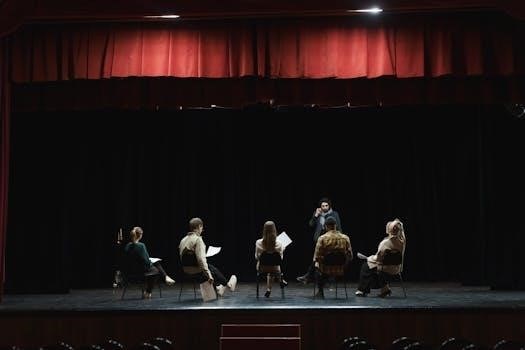Overview of “The Wizard of Oz” Script Play
The “Wizard of Oz” script play, often available in PDF, follows Dorothy’s journey from Kansas to Oz. It includes classic characters like the Scarecrow, Tin Man, and Cowardly Lion. The play adapts L. Frank Baum’s story for stage, using key scenes and plot elements for theatrical performance;
The “Wizard of Oz” script brings to life L. Frank Baum’s beloved tale of Dorothy, a young girl transported to the magical land of Oz by a tornado. This classic story introduces audiences to iconic characters like the Scarecrow, Tin Man, and Cowardly Lion, each seeking something they believe they lack. Their journey together to find the Wizard is filled with challenges and adventures, offering timeless themes of friendship, courage, and self-discovery that resonate across generations; The script captures the heart of the original narrative, making it suitable for both stage and screen adaptations.

Versions of the Script Available in PDF
Numerous “Wizard of Oz” script versions are accessible in PDF format. These include full-length adaptations suitable for larger productions and abridged versions tailored for younger or smaller casts.
Full-Length Versions
Full-length PDF scripts of “The Wizard of Oz” offer complete narratives, encompassing all scenes and musical numbers, designed for comprehensive stage productions. These versions typically follow the original story closely, providing a detailed and immersive experience for both performers and audiences. They include all character interactions, plot developments, and the full scope of the Land of Oz, making them ideal for larger theatre groups and ambitious productions, ensuring a rich and faithful adaptation of the classic story.
Abridged Versions for Younger Performers
Abridged PDF versions of “The Wizard of Oz” scripts are tailored for younger performers, featuring shorter scenes and simplified language. These versions reduce the complexity of the original play, making it more accessible and manageable for children to perform. They typically retain the core story elements and essential character interactions but streamline the narrative to suit shorter attention spans and less experienced actors. This makes them perfect for elementary schools or youth theatre programs.
Youth Edition Adaptations
Youth Edition adaptations of “The Wizard of Oz” scripts in PDF format are designed specifically for young actors. These versions feature simplified language, shorter scenes, and reduced complexity for easier performance.
Simplified Language and Shorter Scenes
The Youth Edition PDF scripts often employ simplified language, making the dialogue easier for younger performers to understand and deliver. Additionally, these adaptations feature shorter scenes which help maintain the pace and attention of child actors. This approach ensures the play is more accessible and manageable for younger casts. The changes are designed to keep the classic story engaging while reducing the performance demands.
Reduced Complexity for Child Actors
Youth-focused “Wizard of Oz” script PDFs are adapted to reduce the complexity of the staging and dialogue. These versions often feature fewer complicated stage directions and character interactions. This reduces the cognitive load on young performers, allowing them to focus on acting and storytelling. The overall goal is to make the play more achievable and enjoyable for children involved in the production, ensuring success.

Character Roles and Casting
The “Wizard of Oz” script offers numerous character roles, including Dorothy, the Scarecrow, and the Wizard. Many versions allow for flexible gender ratios in casting, enhancing inclusivity in productions.
Number of Speaking Parts
The “Wizard of Oz” script typically includes around 27 speaking parts, but this can vary based on the specific adaptation. Some versions are designed for smaller casts, allowing for actors to double up on roles, such as playing multiple munchkins or citizens. This flexibility makes the script adaptable for both large and smaller theatrical groups, ensuring that various productions can be accommodated.
Flexible Gender Ratios
The script for “The Wizard of Oz” offers flexible gender ratios, as seen in productions where the Wizard is played by a woman. This adaptability allows directors to explore different interpretations and cast actors based on talent rather than strictly adhering to traditional gender roles. Some versions are written to accommodate a cast of eight with four women and four men, but other ratios are entirely possible.
Key Scenes and Plot Elements
Key scenes include Dorothy’s tornado transport to Oz and her meeting the Scarecrow, Tin Man, and Cowardly Lion. The central plot involves their quest to see the Wizard, which drives the narrative forward with adventure.
Dorothy’s Journey from Kansas to Oz
Dorothy’s journey begins in a gray Kansas, abruptly interrupted by a powerful tornado. This cyclone transports her and Toto to the vibrant, magical land of Oz. The sudden shift from mundane to fantastical marks the start of her adventure. Her arrival in Oz is a pivotal moment, setting the stage for the characters she will meet and the quest that lies ahead. This initial displacement is crucial for the entire plot.
Meeting the Scarecrow, Tin Man, and Cowardly Lion
On her path through Oz, Dorothy encounters three unique companions. First, she meets the Scarecrow, longing for a brain, followed by the Tin Man, who desires a heart. Lastly, she finds the Cowardly Lion, seeking courage. These characters join her quest to see the Wizard, each hoping for their wish to be granted. Their individual desires and collective journey form the heart of the story.
The Quest to See the Wizard
Driven by their individual longings, Dorothy and her newfound friends embark on a quest to reach the Emerald City and meet the Wizard of Oz. Their journey is fraught with challenges and obstacles set by the Wicked Witch of the West. They believe the Wizard holds the power to grant their wishes, making this trek a crucial part of the play. Their hope motivates them forward.
Themes and Messages
The play explores themes like finding courage, heart, and intelligence. It highlights the importance of home and self-discovery. The journey reveals that inner strength is what truly matters.
Finding Courage, Heart, and Intelligence
The characters’ quest for these qualities is central to the “Wizard of Oz” narrative. The Scarecrow seeks brains, the Tin Man desires a heart, and the Cowardly Lion longs for courage, demonstrating that these attributes are inherent within themselves and are discovered through their journey. The play emphasizes self-acceptance and the recognition of internal strengths, rather than relying solely on external sources, which is key for the development of characters.
The Importance of Home
Dorothy’s longing to return to Kansas is a major theme, highlighting the value of home. Throughout her adventures in Oz, she seeks a way back, realizing that there’s “no place like home”. The play showcases the comfort and security found in familiar surroundings, and emphasizes that true happiness isn’t always in fantastical places, but within family and a place of belonging. The desire for home drives her actions in the play.
Copyright and Usage
Performance rights for “The Wizard of Oz” scripts require permission. Educational uses also have guidelines. Copyright protects the script and its adaptations, ensuring proper usage in productions and classrooms.
Permissions for Performance
Securing performance rights is crucial before staging “The Wizard of Oz.” These rights are typically obtained through licensing agencies that represent the copyright holders. Obtaining proper permission ensures that the production is legally compliant and that the creators receive appropriate compensation for the use of their work. This process is essential for both amateur and professional theater groups. Failing to obtain the rights is considered a copyright violation and can lead to legal repercussions. Always check the guidelines provided by the script publisher.
Educational Use Guidelines
Educational use of “The Wizard of Oz” script often allows for classroom readings and study, but performance rights may still be needed. Schools can typically use the script for educational purposes, such as acting exercises, scene work, and literary analysis. Always check the specific publisher’s guidelines for permission to use the materials. Some publishers offer student-friendly versions or classroom resources that are tailored for educational settings. Ensure that any use is aligned with the publisher’s policies.

Resources for Production
Production resources include stage play scripts for schools and theaters. Libretto transcripts are also available. These materials aid in staging, character development, and overall performance quality of “The Wizard of Oz”.
Stage Play Scripts for Schools and Theaters
Numerous stage play scripts of “The Wizard of Oz” are designed specifically for school and theater productions. These scripts often include detailed stage directions, character descriptions, and scene breakdowns, making them ideal for educational and amateur theatrical use. They are available in various formats, including PDF, to facilitate easy access and printing, supporting a wide range of performances from small school groups to larger theatrical companies.
Libretto Transcripts
Libretto transcripts for “The Wizard of Oz,” often available in PDF format, provide the complete text of the musical’s dialogue and song lyrics. These transcripts are essential for musical productions, allowing performers and directors to accurately follow the script. The libretto includes cues for music, stage actions, and character movements, making it a comprehensive resource for staging the musical adaptation of the story. They can be found online for various versions.
Adaptations and Variations
Numerous adaptations of “The Wizard of Oz” exist, including the RSC version and interactive plays. These variations offer unique interpretations of the classic story, often with modifications to suit different performance styles and audiences.
RSC Version
The Royal Shakespeare Company (RSC) version of “The Wizard of Oz” provides a distinctive theatrical experience. This adaptation often includes unique staging, character interpretations, and musical arrangements. The RSC version aims to capture the magic and wonder of the original story while offering a fresh perspective on the beloved narrative. The libretto for the RSC version is sometimes available in PDF format for study and performance.
Interactive Play Versions
Interactive play versions of “The Wizard of Oz” encourage audience participation, making the theatrical experience more engaging. These versions often include moments where the audience can sing along, shout out responses, or even influence the plot. This format creates a dynamic and fun environment for all ages. Some interactive scripts are available in PDF, offering flexibility for different performance settings.
Additional Production Notes
Successful productions of “The Wizard of Oz” require careful consideration of costumes, set design, music and songs. These elements bring the magical world of Oz to life and enhance the theatrical experience.
Costume and Set Design
Costume design for “The Wizard of Oz” often includes iconic outfits, such as Dorothy’s blue gingham dress, the Scarecrow’s straw-filled attire, the Tin Man’s metallic shell, and the Cowardly Lion’s mane. Set designs usually feature both the grey, drab Kansas farm and the vibrant, colorful Land of Oz, often utilizing creative backdrops and props to distinguish between the two worlds, enhancing the magical journey.
Music and Songs
The musical elements in “The Wizard of Oz” script play are crucial, featuring beloved songs like “Over the Rainbow,” “We’re Off to See the Wizard,” and “Ding-Dong! The Witch Is Dead.” These songs often provide emotional depth, character development, and enhance the overall theatrical experience. The music is integral to moving the narrative and creating the magical atmosphere of Oz, captivating audiences of all ages.

Where to Find Script PDF Files
Script PDF files for “The Wizard of Oz” are available through various sources. You can find free downloads on some sites, while others offer purchase options for licensed versions of the play.
Free Downloads
Many websites offer “The Wizard of Oz” script as a free PDF download. These versions often include abridged or adapted scripts suitable for educational use or community theatre productions. It’s essential to verify the source’s legitimacy and understand that these free options might not always be the full-length, licensed versions. Some may be for specific adaptations, like youth editions, so check the details carefully before downloading.
Purchase Options
For full-length, professionally licensed “Wizard of Oz” scripts, purchasing from reputable publishers is necessary. These options usually come with performance rights and are available as PDF downloads after purchase. These scripts often include the original music and detailed stage directions. Purchasing ensures compliance with copyright laws and provides access to high-quality materials specifically designed for theatrical productions, which is important for larger or professional productions.
Interactive and Participatory Elements
Some “Wizard of Oz” script versions encourage audience interaction. This might include sing-alongs, call-and-response, or even opportunities for the audience to influence the storyline making the play a fun experience for all.
Audience Involvement in the Play
Many productions of “The Wizard of Oz” script play integrate audience participation to enhance the theatrical experience. This could involve encouraging sing-alongs during iconic musical numbers, prompting cheers or boos for specific characters, or even having the audience help make decisions. These interactive elements create a more engaging and immersive environment, making the play a fun event. These techniques ensure the audience feel like they are part of Dorothy’s fantastical journey through Oz.